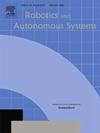Kinematics characteristic analysis of a type of human-machine compatible ankle rehab robots based on human-ankle IFHA identification
IF 4.3
2区 计算机科学
Q1 AUTOMATION & CONTROL SYSTEMS
引用次数: 0
Abstract
Existing ankle rehabilitation robots lack reference to the actual ankle motion posture of humans, leading to a mismatch with the natural motion of the ankle joint and affecting the rehabilitation outcome. This paper uses screw theory and motion capture equipment to identify the instantaneous finite helical motion axis (IFHA) of the human ankle and obtains the distribution law of the instantaneous rotational axis and translational pitch of the ankle, and based on this, design a human-machine motion compatible rope-driven ankle joint rehabilitation robot that aligns with human motion for ankle joint rehabilitation. Firstly, the experimental trajectories of human ankle dorsiflexion(DF) /plantarflexion(PF), inversion(IN)/ eversion(EN), and adduction(AD)/abduction(AB)/ are taken by using the VICON motion capture system, and the experimental data are analyzed and processed according to the screw theory. The distribution law of the IFHA and the range of twist pitch (TP) are obtained. Secondly, according to the motion characteristics of the ankle joint obtained from the experiment, the constraint characteristics of the ankle rehabilitation mechanism are obtained, and it is mapped into a series of parallel mechanisms to meet the rehabilitation needs. Select a configuration as the skeleton of the robot, design a prototype of the novel rope-driven rehabilitation robot, and establish its kinematic model. Then, analyze the kinematic characteristics of the mechanism by combining screw theory and spatial analytic geometry theory. Finally, the experimental platform of the ankle rehabilitation robot is built to verify the accuracy of human-machine motion fitting, safety, comfort, and effectiveness of the rehabilitation robot.

基于人踝IFHA识别的人机兼容踝关节康复机器人运动学特性分析
现有的踝关节康复机器人缺乏对人类踝关节实际运动姿势的参考,导致与踝关节的自然运动不匹配,影响康复效果。本文利用螺旋理论和运动捕捉设备对人体踝关节的瞬时有限螺旋运动轴(IFHA)进行识别,得到踝关节瞬时旋转轴和平移节距的分布规律,并在此基础上设计出符合人体运动的人机运动兼容绳驱动踝关节康复机器人,用于踝关节康复。首先,利用VICON运动捕捉系统拍摄人体踝关节背屈(DF) /跖屈(PF)、内翻(IN)/外翻(EN)、内收(AD)/外展(AB)/的实验轨迹,并根据螺钉理论对实验数据进行分析和处理。得到了IFHA的分布规律和扭转节距(TP)范围。其次,根据实验得到的踝关节运动特性,得到踝关节康复机构的约束特性,并将其映射成一系列并联机构,以满足康复需求。选择一种构型作为机器人的骨架,设计了新型绳驱动康复机器人样机,并建立了其运动学模型。然后,结合螺旋理论和空间解析几何理论对机构的运动特性进行了分析。最后搭建了踝关节康复机器人实验平台,验证了该康复机器人人机运动拟合的准确性、安全性、舒适性和有效性。
本文章由计算机程序翻译,如有差异,请以英文原文为准。
求助全文
约1分钟内获得全文
求助全文
来源期刊

Robotics and Autonomous Systems
工程技术-机器人学
CiteScore
9.00
自引率
7.00%
发文量
164
审稿时长
4.5 months
期刊介绍:
Robotics and Autonomous Systems will carry articles describing fundamental developments in the field of robotics, with special emphasis on autonomous systems. An important goal of this journal is to extend the state of the art in both symbolic and sensory based robot control and learning in the context of autonomous systems.
Robotics and Autonomous Systems will carry articles on the theoretical, computational and experimental aspects of autonomous systems, or modules of such systems.
 求助内容:
求助内容: 应助结果提醒方式:
应助结果提醒方式:


